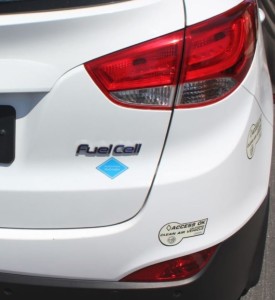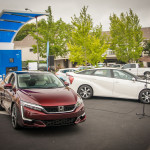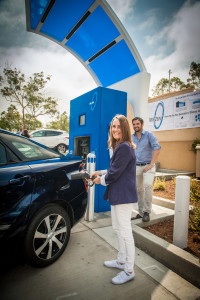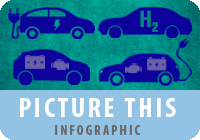The Tri-Counties Hydrogen Readiness Plan is now available below.
How Hydrogen Fuel Cell Electric Vehicles Work
 Hydrogen fuel cell electric vehicles (FCEVs) release no tailpipe emissions. The vehicles use compressed hydrogen gas for fuel, and electricity produced by the fuel cell is used to power the car’s electric motor. The process works like this: hydrogen (from an onboard storage tank) and oxygen (from the surrounding air) are fed into a fuel cell consisting of three parts — anode, cathode, and proton exchange membrane. The anode separates incoming hydrogen atoms into protons and electrons, and the electrons then flow through an electrical circuit to generate electricity. At the end of the process, the cathode pulls the electrons, protons, and oxygen back together to form water. This water, some air, and a bit of heat are the only byproducts of hydrogen fuel cells.
Hydrogen fuel cell electric vehicles (FCEVs) release no tailpipe emissions. The vehicles use compressed hydrogen gas for fuel, and electricity produced by the fuel cell is used to power the car’s electric motor. The process works like this: hydrogen (from an onboard storage tank) and oxygen (from the surrounding air) are fed into a fuel cell consisting of three parts — anode, cathode, and proton exchange membrane. The anode separates incoming hydrogen atoms into protons and electrons, and the electrons then flow through an electrical circuit to generate electricity. At the end of the process, the cathode pulls the electrons, protons, and oxygen back together to form water. This water, some air, and a bit of heat are the only byproducts of hydrogen fuel cells.
Comparison to Other Vehicles
- Fuel Cell Electric Vehicles — rely primarily on hydrogen for fuel to produce electricity
- Internal Combustion Vehicles — typically powered by the burning of petroleum fuels
- Battery Electric Vehicles — powered by electricity that is stored onboard in rechargeable batteries
- Hybrid Vehicles — powered by both an internal combustion engine and a rechargeable battery
- Plug-In Hybrid Vehicles — hybrid vehicles with larger batteries that can be recharged when the vehicle is not in use
Benefits of FCEVs
 High efficiency: the current generation of FCEVs get the equivalent of 50 MPG or more
High efficiency: the current generation of FCEVs get the equivalent of 50 MPG or more- Long driving ranges: 300+ miles of driving on a single tank of hydrogen
- Quick refills: 3-5 minute fueling times
- 40 to 50 percent fewer greenhouse gas emissions compared to similar gasoline-fueled vehicles
- Zero tailpipe emissions
Tri-Counties Hydrogen Readiness Plan
On April 8, 2015, the California Energy Commission approved a grant for the Santa Barbara County Air Pollution Control District to facilitate the adoption of hydrogen-powered vehicles in the Tri-Counties (Santa Barbara, Ventura, San Luis Obispo) region. In efforts to reduce California’s dependence on petroleum transportation fuels the Santa Barbara County Air Pollution Control District collaborated with the Ventura County Air Pollution Control District, the San Luis Obispo County Air Pollution Control District, and other organizations to develop a plan that will expand the reach of hydrogen infrastructure beyond the main urban centers of California.
Tri-Counties Hydrogen Readiness Plan
Appendix A: Summary of Adopted County Plans
Appendix B: Modeling and Field Assessment Results
B-1: Application of STREET for Tri-Counties Hydrogen Readiness Plan
B-2: Field Assessment of Existing Retail Fueling Stations
Appendix C: Hydrogen Station Permitting Guide
C-1: GO-Biz Hydrogen Permitting Guidebook
C-2: NREL Guide to Permitting Hydrogen Motor Fuel Dispensing Facilities
C-3: NREL – Regs, Codes and Standards for California Hydrogen Dispensing Stations
C-4: DOE Introduction to Hydrogen for Code Officials
C-5: DOE Hydrogen Tools Videos
C-6: DOE Clean Cities H2 Readiness – Best Practices for Early Adopter Communities
C-7: NFPA-2 Summary and Adoption by California
C-8: Contacts made with Permit Agencies
Appendix D: Promotion and Outreach
Appendix E: Resources for Hydrogen Safety, Awareness, and Response
E-1: Hydrogen Safety Awareness
E-2: First Responder Training Resources for Hydrogen Awareness and Response
E-3: Fuel Cell Vehicle Emergency Response Manuals
E-4: Orientation and Training Provided to Tri-Counties Fire Officers
E-5: First Responder Alternative Fuels Training Toolkit
Appendix F: Fleets
Appendix G: Administrative

Learn More

For more information about Santa Barbara’s hydrogen station (including location, available fuel pressures, and hours), enter a Santa Barbara zip code and click on “Details.”
For more information on FCEVs, including safety features, see California Fuel Cell Partnership.
For more information about California’s hydrogen transportation initiatives, see the California Air Resources Board.
Read about different types of clean-air cars and see the California Air Resources Board’s buying guide.


